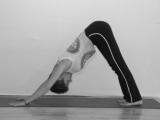
Adho Mukha Svanasana
Encyclopedia

IAST
The International Alphabet of Sanskrit Transliteration is a transliteration scheme that allows a lossless romanization of Indic scripts as employed by the Sanskrit language.-Popularity:...
: Adho Mukha Śvānāsana), Downward-Facing Dog Pose, Downward Dog, or Down Dog, is an asana
Asana
Asana is a body position, typically associated with the practice of Yoga, originally identified as a mastery of sitting still, with the spine as a conduit of biodynamic union...
.
Etymology
The name comes from the Sanskrit words adhas (अधस्, Adhas) meaning "down", mukha (मुख, Mukha) meaning "face", svana or shvana (श्वान, śvāna) meaning "dog", and asana (आसन) meaning "posture" or "seat".Anatomical Focus
Primary Muscles:- Trapezius (Traps), Latissimus Dorsi (Lats), Triceps, Gluteus Maximus (glutes), Hamstrings, Full Body/Integrated
Secondary Muscles (Synergists/Stabilizers):
- RhomboidsRhomboidsRhomboids can refer to:* Rhomboid muscles** Rhomboid major muscle** Rhomboid minor muscle...
, Rotator cuffRotator cuffIn anatomy, the rotator cuff is the group of muscles and their tendons that act to stabilize the shoulder. The four muscles of the rotator cuff, along with the teres major muscle, the coracobrachialis muscle and the deltoid, make up the seven scapulohumeral muscles of the human body.-Function:The...
, Anterior and Medial Deltoids (delts), Posterior Deltoids (delts), Extensors, Serratus Anterior, Soleus, Gastrocnemius Body/Integrated
Description
The preparatory position is with the hands and knees on the floor, hands under the shoulders, fingers spread wide, knees under the hips and typically about seven inches (17 cm) apart, with the spine straightened and relaxed.On a deep exhale, the hips are pushed toward the ceiling, the body forming an inverted V-shape. The back is straight with the front ribs tucked in. The legs are straight with the heels reaching to the floor. The hands are open like starfish, keeping the forefinger and thumb pressing down on the floor/mat. The arms are straight, with the inner elbows turning towards the ceiling. If one has the tendency to hyper extend elbows, keeping a microbend to the elbows prevents taking the weight in the joints. Turning the elbows up towards the ceiling will engage the triceps and build strength. The shoulders are wide and relaxed. Line up the ears with the inner arms which keeps the neck lengthened. The hands are shoulder width apart and feet remain hip-width apart. If the hamstrings are very strong or tight, the knees are bent to allow the spine to lengthen fully. The navel is drawn in towards the spine, keeping the core engaged.
The hips move up and back. Focus is on the breath while holding the posture, with deep, steady inhalation and exhalation creating a flow of energy through the body. On an exhale, the practitioner releases onto the hands and knees and rests in balasana
Balasana
Balasana , Child's Pose, or Child's Resting Pose, is an asana.- Etymology :The name comes from the Sanskrit words bala meaning "child" and asana meaning "posture" or "seat".- Description :...
(child's pose).
Benefits
BKS Iyengar asserts that this posture stretches the shoulders, legs, spineVertebral column
In human anatomy, the vertebral column is a column usually consisting of 24 articulating vertebrae, and 9 fused vertebrae in the sacrum and the coccyx. It is situated in the dorsal aspect of the torso, separated by intervertebral discs...
and whole body; builds strength
Physical strength
Physical strength is the ability of a person or animal to exert force on physical objects using muscles. Increasing physical strength is the goal of strength training.-Overview:...
throughout the body, particularly the arms, legs, and feet; relieves fatigue
Fatigue (physical)
Fatigue is a state of awareness describing a range of afflictions, usually associated with physical and/or mental weakness, though varying from a general state of lethargy to a specific work-induced burning sensation within one's muscles...
and rejuvenates the body; improves the immune system
Immune system
An immune system is a system of biological structures and processes within an organism that protects against disease by identifying and killing pathogens and tumor cells. It detects a wide variety of agents, from viruses to parasitic worms, and needs to distinguish them from the organism's own...
, digestion and blood flow
Circulatory system
The circulatory system is an organ system that passes nutrients , gases, hormones, blood cells, etc...
to the sinuses
Paranasal sinus
Paranasal sinuses are a group of four paired air-filled spaces that surround the nasal cavity , above and between the eyes , and behind the ethmoids...
, and calms the mind and lifts the spirits.
See also
- Sūrya namaskāraSurya NamaskaraSurya Namaskara , known in English as Sun Salutation , is a common sequence of Hatha yoga asanas. Its origins lie in a worship of Surya, the Hindu solar deity...
- List of Hatha yoga postures

